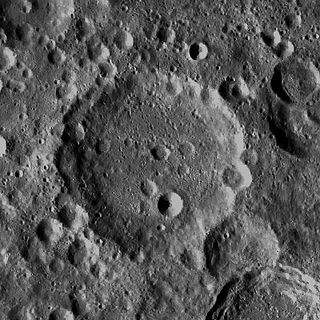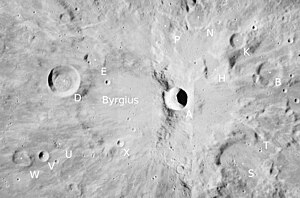
Anderson is a lunar impact crater that is located on the far side of the Moon. It is located to the northwest of the crater Sharonov, and the satellite crater Sharanov X is attached to the southeast rim of Anderson. To the northeast is the peculiar formation Buys-Ballot, and to the east-southeast lies the larger crater Spencer Jones.

Argelander is a lunar impact crater that is located in the south-central highlands of the Moon. It was named after the German astronomer Friedrich Argelander. It lies in the midpoint between the smaller crater Vogel in the north and the larger Airy to the south. To the northwest is the worn remnant of Parrot. Just to the west is a shallow cleft in the surface that follows a course to the north-northwest, intersecting the southeast rim of Parrot.

Chladni is a small lunar impact crater that lies near the northwest edge of Sinus Medii, in the central part of the Moon. The crater is named for German physicist and musician Ernst Chladni who, in 1794, wrote the first book on meteorites. The rim of the crater is roughly circular, and there is a small central floor at the midpoint of the sloping inner walls. This feature has a higher albedo than the surrounding terrain. It is connected by a low ridge to the rim of the crater Murchison, which lies to the northwest. Due east of Chladni is the larger Triesnecker.

Faraday is a lunar impact crater in the southern highlands of the Moon. It was named after British chemist and physicist Michael Faraday. It lies across the southeast rim of the larger crater Stöfler, and the northwest rim of Faraday forms a wide rampart across the otherwise flat floor of Stöfler. To the east of Faraday is Maurolycus.

Dawson is a lunar impact crater that lies on the southern hemisphere on the far side of the Moon. It lies across a crater triplet: the southeast rim is intruding into the crater Alekhin; the northwest rim also intrudes into the larger satellite crater Dawson V, and the northeast rim is attached to the comparably sized Dawson D. To the south of this formation is the large crater Zeeman. West of Dawson is the crater Crommelin, and to the north lies Fizeau.

Fizeau is a prominent lunar impact crater that is located on the far side of the Moon, in the southern hemisphere. Nearby craters of note include Minkowski to the west-northwest, and Eijkman to the southwest.

Chamberlin is a lunar impact crater that is located on the far side of the Moon, just past the southeastern limb. It lies to the southeast of the crater Jeans, and Moulton is attached to the southeastern rim of Chamberlin. This crater is located in a part of the lunar surface that has undergone resurfacing of crater interiors, producing dark-hued crater floors.

Bellinsgauzen is a lunar impact crater that lies in the southern part of Moon, on the far side from the Earth. It is attached to the northern rim of the larger crater Berlage, and within a half crater diameter of Cabannes to the west. North of Bellinsgauzen is the crater Bhabha.

Berlage is an old lunar impact crater that lies in the southern hemisphere on the far side of the Moon. The smaller crater Bellinsgauzen is attached to its northern rim, and Cabannes is less than one crater diameter to the northwest. To the east-northeast of Berlage is Lemaître.

Berkner is a lunar impact crater that is located on the far side of the Moon, just past the western limb. It is attached to the east-southeast rim of the crater Parenago. Just to the south is the Robertson, and to the southeast is Helberg.

Berosus is a lunar impact crater that is located in the northeast part of the Moon, less than one crater diameter northwest of Hahn. Further to the east-northeast is the large crater Gauss, and to the north-northwest lies Bernoulli. Because of its location, this crater appears foreshortened when viewed from the Earth.

Blanchard is a lunar impact crater that lies on the far side of the Moon, just behind the southwestern limb. It lies to the south-southwest of the crater Arrhenius, and northwest of Pilâtre. Further to the south is the rugged terrain to the north of the walled plain Hausen.

Belopolʹskiy is a lunar impact crater that is located on the far side of the Moon. It lies to the west of the crater Houzeau, and northeast of Strömgren. Just to the northwest of Belopolʹskiy is the crater Ioffe.

Esclangon is a lunar impact crater that is located in the rugged terrain to the northwest of the prominent crater Macrobius, and east of Sinus Amoris. Its diameter is 15 km. It was named after French astronomer Ernest Esclangon. This formation was previously designated Macrobius L. Just to the west-southwest is the crater Hill. Lacus Bonitatis, the Lake of Good, is located to the east and northeast of Esclangon.

Coblentz is a small lunar impact crater that is located on the far side of the Moon, to the south of the much larger crater Bolyai. This crater retains a circular rim, but it has been worn by impact erosion. This is particularly so at the southern end where an irregular gap exists in the rim. The interior floor is relatively featureless save for several tiny craterlets.

Clairaut is a lunar impact crater that is located in the rugged southern highlands of the Moon's near side. It lies directly to the south of the crater Maurolycus and southeast of Barocius. Just to the southwest is Cuvier.

Chappell is a lunar impact crater on the far side of the Moon, in the northern hemisphere just to the north of the crater Debye. It is in a heavily bombarded section of the surface, and much of its outer rim is overlain by smaller craters. The northern rim in particular has been almost completely disintegrated, while small craters also overlie the rim to the northwest and southeast. What remains of the rim forms a rounded, somewhat irregular edge to the crater depression.

Coriolis is a lunar impact crater that is located on the far side of the Moon. The crater floor is bisected by the lunar equator, and it lies about three crater diameters northwest of the crater Daedalus.

Fourier is a lunar impact crater that is located in the southwestern part of the Moon's near side, just to the southeast of the crater Vieta. To the northeast is the Mare Humorum. The rim of this crater is roughly circular, but appears oval when viewed from the Earth due to foreshortening.

Feoktistov is a small lunar impact crater on the far side of the Moon. It lies in the northern hemisphere, to the northwest of the Mare Moscoviense. This crater has a small outward extension along the northern side, giving it the appearance of two overlapping craters that have merged. There are slight indentations of the rim along the east and northwest sides. The rim is otherwise rounded and not significantly worn. Apart from an irregular strip in the northeast, the floor is relatively featureless.























